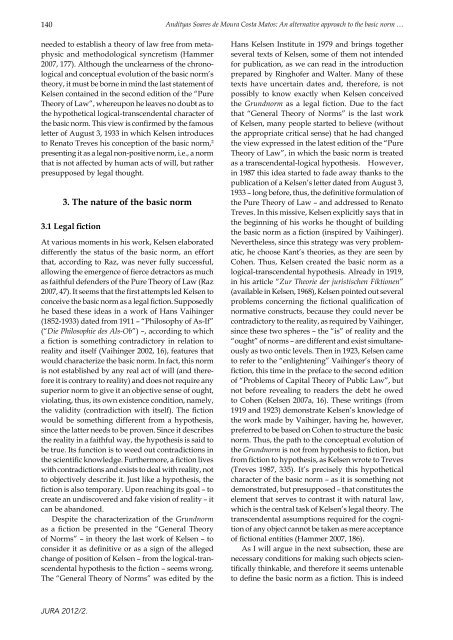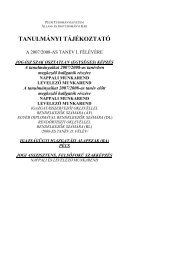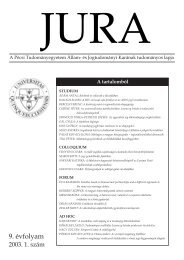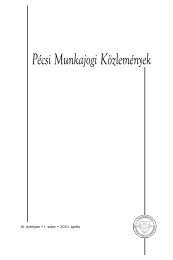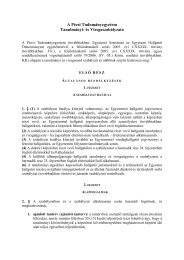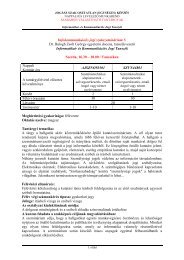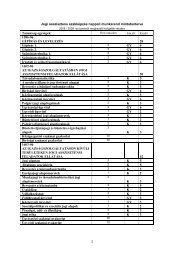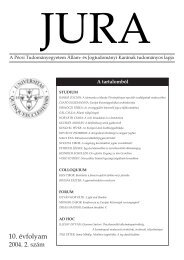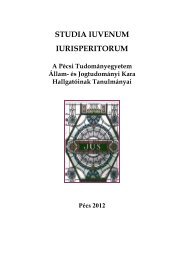2012. évi 2. szám - Jura - Pécsi Tudományegyetem
2012. évi 2. szám - Jura - Pécsi Tudományegyetem
2012. évi 2. szám - Jura - Pécsi Tudományegyetem
- TAGS
- jura
You also want an ePaper? Increase the reach of your titles
YUMPU automatically turns print PDFs into web optimized ePapers that Google loves.
140 Andityas Soares de Moura Costa Matos: An alternative approach to the basic norm …needed to establish a theory of law free from metaphysicand methodological syncretism (Hammer2007, 177). Although the unclearness of the chronologicaland conceptual evolution of the basic norm’stheory, it must be borne in mind the last statement ofKelsen contained in the second edition of the “PureTheory of Law”, whereupon he leaves no doubt as tothe hypothetical logical-transcendental character ofthe basic norm. This view is confirmed by the famousletter of August 3, 1933 in which Kelsen introducesto Renato Treves his conception of the basic norm, 2presenting it as a legal non-positive norm, i.e., a normthat is not affected by human acts of will, but ratherpresupposed by legal thought.3. The nature of the basic norm3.1 Legal fictionAt various moments in his work, Kelsen elaborateddifferently the status of the basic norm, an effortthat, according to Raz, was never fully successful,allowing the emergence of fierce detractors as muchas faithful defenders of the Pure Theory of Law (Raz2007, 47). It seems that the first attempts led Kelsen toconceive the basic norm as a legal fiction. Supposedlyhe based these ideas in a work of Hans Vaihinger(1852-1933) dated from 1911 – “Philosophy of As-If”(“Die Philosophie des Als-Ob”) –, according to whicha fiction is something contradictory in relation toreality and itself (Vaihinger 2002, 16), features thatwould characterize the basic norm. In fact, this normis not established by any real act of will (and thereforeit is contrary to reality) and does not require anysuperior norm to give it an objective sense of ought,violating, thus, its own existence condition, namely,the validity (contradiction with itself). The fictionwould be something different from a hypothesis,since the latter needs to be proven. Since it describesthe reality in a faithful way, the hypothesis is said tobe true. Its function is to weed out contradictions inthe scientific knowledge. Furthermore, a fiction liveswith contradictions and exists to deal with reality, notto objectively describe it. Just like a hypothesis, thefiction is also temporary. Upon reaching its goal – tocreate an undiscovered and fake vision of reality – itcan be abandoned.Despite the characterization of the Grundnormas a fiction be presented in the “General Theoryof Norms” – in theory the last work of Kelsen – toconsider it as definitive or as a sign of the allegedchange of position of Kelsen – from the logical-transcendentalhypothesis to the fiction – seems wrong.The “General Theory of Norms” was edited by theHans Kelsen Institute in 1979 and brings togetherseveral texts of Kelsen, some of them not intendedfor publication, as we can read in the introductionprepared by Ringhofer and Walter. Many of thesetexts have uncertain dates and, therefore, is notpossibly to know exactly when Kelsen conceivedthe Grundnorm as a legal fiction. Due to the factthat “General Theory of Norms” is the last workof Kelsen, many people started to believe (withoutthe appropriate critical sense) that he had changedthe view expressed in the latest edition of the “PureTheory of Law”, in which the basic norm is treatedas a transcendental-logical hypothesis. However,in 1987 this idea started to fade away thanks to thepublication of a Kelsen’s letter dated from August 3,1933 – long before, thus, the definitive formulation ofthe Pure Theory of Law – and addressed to RenatoTreves. In this missive, Kelsen explicitly says that inthe beginning of his works he thought of buildingthe basic norm as a fiction (inspired by Vaihinger).Nevertheless, since this strategy was very problematic,he choose Kant’s theories, as they are seen byCohen. Thus, Kelsen created the basic norm as alogical-transcendental hypothesis. Already in 1919,in his article “Zur Theorie der juristischen Fiktionen”(available in Kelsen, 1968), Kelsen pointed out severalproblems concerning the fictional qualification ofnormative constructs, because they could never becontradictory to the reality, as required by Vaihinger,since these two spheres – the “is” of reality and the“ought” of norms – are different and exist simultaneouslyas two ontic levels. Then in 1923, Kelsen cameto refer to the “enlightening” Vaihinger’s theory offiction, this time in the preface to the second editionof “Problems of Capital Theory of Public Law”, butnot before revealing to readers the debt he owedto Cohen (Kelsen 2007a, 16). These writings (from1919 and 1923) demonstrate Kelsen’s knowledge ofthe work made by Vaihinger, having he, however,preferred to be based on Cohen to structure the basicnorm. Thus, the path to the conceptual evolution ofthe Grundnorm is not from hypothesis to fiction, butfrom fiction to hypothesis, as Kelsen wrote to Treves(Treves 1987, 335). It’s precisely this hypotheticalcharacter of the basic norm – as it is something notdemonstrated, but presupposed – that constitutes theelement that serves to contrast it with natural law,which is the central task of Kelsen’s legal theory. Thetranscendental assumptions required for the cognitionof any object cannot be taken as mere acceptanceof fictional entities (Hammer 2007, 186).As I will argue in the next subsection, these arenecessary conditions for making such objects scientificallythinkable, and therefore it seems untenableto define the basic norm as a fiction. This is indeedJURA 2012/<strong>2.</strong>


